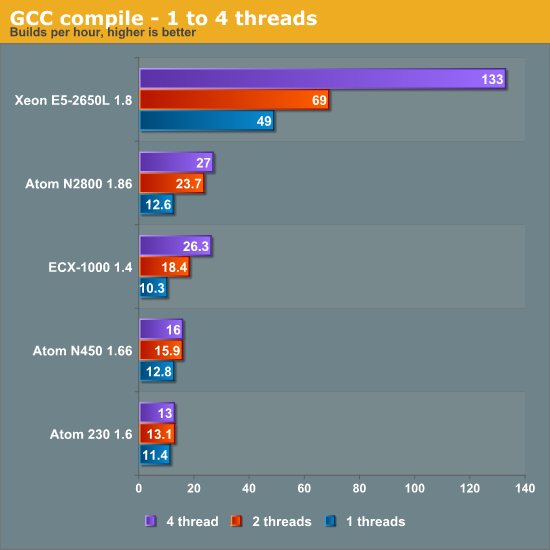Calxeda's ARM server tested
by Johan De Gelas on March 12, 2013 7:14 PM EST- Posted in
- IT Computing
- Arm
- Xeon
- Boston
- Calxeda
- server
- Enterprise CPUs
Building and Compiling
We compiled the 7z source by performing a make -jx (with x being the number of threads). Compiling is branch intensive (22%) workload that does mostly loads and stores (about 40%).
Looking at the single-thread performance, the ARM Cortex-A9 and Atom are in the same ballpark. This is the kind of workload where the Sandy Bridge core of the Xeon really shines. You need about eight Cortex-A9 cores to beat one Xeon (without HT). And it must be said: compiling inside a virtual machine on top of the Xeon E5 is a very pleasant experience compared to the long wait times on the Atom and ECX.

Lessons so Far
A quad-core Cortex-A9 performs well in server workloads that are mostly memory latency sensitive. A quad-core Cortex-A9 ECX-1000 at 1.4GHz has no trouble competing with Atoms at slightly higher clockspeeds (1.6GHz). There is only one exception: bandwidth intensive workloads.
Both Atom and ARM based servers have the disadvantage of being rather slow in typical "management" tasks such as compiling, installing, and updating new software. Compiling a rather simple piece of software in a VM with only two Xeon vCPUs (running on one 1 core + HTT) took only 37 seconds. A single-core Atom server needed 275 seconds, while the quad-core ARM ECX-1000 needed 137 seconds.
But the Boston Viridis is much more than just a chassis with 24 server nodes. It has a high performance switching fabric. So it's time to see what this server can do in a real server environment.










99 Comments
View All Comments
JohanAnandtech - Wednesday, March 13, 2013 - link
Hmmm ... There is almost no info on how that hypervisor works. It is hard to imagine that kind of system would scale very well. How does it keep Cache coherent? Do you have info on that?timbuktu - Wednesday, March 13, 2013 - link
I can't speak directly to ScaleMP, but it looks similar to NUMALink.http://en.wikipedia.org/wiki/NUMAlink
Reading through this article about Calxedas, great job BTW, I couldn't help but think about the old SGI hardware that seemed pretty similar with MIPs (and later Itanium) processors connected through a switch with NUMALink. I haven't played with NUMALink directly in almost a decade, but back then cheaper Altix slabs were ring topology while higher end hardware was switched. In the end though, you could put together a bunch of 1U racks together and have a single system image. Like you mentioned though, cache coherency was exceptionally important. Since we have a uv here, I can point you to the documentation for that box.
http://techpubs.sgi.com/library/tpl/cgi-bin/getdoc...
Everything old is new again, I suppose. Well, except NUMAlink never went away. =D
Tunrip - Wednesday, March 13, 2013 - link
I'd be interested in knowing how the Xeon compared if you did the same test without the virtual machines.JohanAnandtech - Wednesday, March 13, 2013 - link
The website won't scale to 32 logical cores I am afraid... but we can try to see how far we can getColin1497 - Wednesday, March 13, 2013 - link
A better question might be "is 24 VM's a logical number to use?" Would more or fewer VM's work better? The appearance is that you have 24VM's because you have 24 ARM nodes?duploxxx - Wednesday, March 13, 2013 - link
very interesting, loved reading it. But although early in the ball game I do think there are other way better solutions in the pipe-line from the big OEM:HP Moonshot
http://h17007.www1.hp.com/us/en/iss/110111.aspx
JohanAnandtech - Wednesday, March 13, 2013 - link
Isn't remarkable how PR people manage to fill so many pages with "extreme" and "the future" without telling anything. Frustation became even higher when I clicked "get the facts" page. That is more like "You are not getting any facts at all".DuckieHo - Wednesday, March 13, 2013 - link
Since these are set up as webservers, what's the power consumption at say 20-40% load? Usually there is some load instead of completely idle.JohanAnandtech - Wednesday, March 13, 2013 - link
Good suggestion... you'll like to see a step by step power measurement like SpecPower right? Let me try that.DanNeely - Wednesday, March 13, 2013 - link
I'd be interested in seeing where, and what happens when you start pushing single chips to and slightly beyond their limits. Calxeda's hardware's proved competitive on a very friendly workload (which I didn't really expect would happen until their A15 product); but in the real world a set of small websites are unlikely to all have equal load levels. Virtual servers on larger CPUs should give more headroom for load spikes; so knowing what the limits on Calxeda's hardware are strikes me as fairly important.